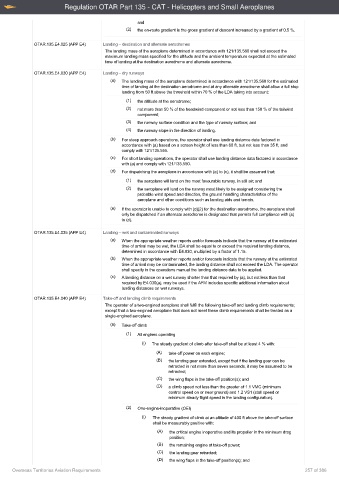Page 257 - Overseas Territories Aviation Requirements Consolidated - Total AOC
P. 257
Regulation OTAR Part 135 - CAT - Helicopters and Small Aeroplanes
and
(2) the en-route gradient is the gross gradient of descent increased by a gradient of 0.5 %.
OTAR.135.E4.025 (APP E4) Landing – destination and alternate aerodromes
The landing mass of the aeroplane determined in accordance with 121/135.560 shall not exceed the
maximum landing mass specified for the altitude and the ambient temperature expected at the estimated
time of landing at the destination aerodrome and alternate aerodrome.
OTAR.135.E4.030 (APP E4) Landing – dry runways
(a) The landing mass of the aeroplane determined in accordance with 121/135.560 for the estimated
time of landing at the destination aerodrome and at any alternate aerodrome shall allow a full stop
landing from 50 ft above the threshold within 70 % of the LDA taking into account:
(1) the altitude at the aerodrome;
(2) not more than 50 % of the headwind component or not less than 150 % of the tailwind
component;
(3) the runway surface condition and the type of runway surface; and
(4) the runway slope in the direction of landing.
(b) For steep approach operations, the operator shall use landing distance data factored in
accordance with (a) based on a screen height of less than 60 ft, but not less than 35 ft, and
comply with 121/135.555.
(c) For short landing operations, the operator shall use landing distance data factored in accordance
with (a) and comply with 121/135.550.
(d) For dispatching the aeroplane in accordance with (a) to (c), it shall be assumed that:
(1) the aeroplane will land on the most favourable runway, in still air; and
(2) the aeroplane will land on the runway most likely to be assigned considering the
probable wind speed and direction, the ground handling characteristics of the
aeroplane and other conditions such as landing aids and terrain.
(e) If the operator is unable to comply with (d)(2) for the destination aerodrome, the aeroplane shall
only be dispatched if an alternate aerodrome is designated that permits full compliance with (a)
to (d).
OTAR.135.E4.035 (APP E4) Landing – wet and contaminated runways
(a) When the appropriate weather reports and/or forecasts indicate that the runway at the estimated
time of arrival may be wet, the LDA shall be equal to or exceed the required landing distance,
determined in accordance with E4.030, multiplied by a factor of 1.15.
(b) When the appropriate weather reports and/or forecasts indicate that the runway at the estimated
time of arrival may be contaminated, the landing distance shall not exceed the LDA. The operator
shall specify in the operations manual the landing distance data to be applied.
(c) A landing distance on a wet runway shorter than that required by (a), but not less than that
required by E4.030(a), may be used if the AFM includes specific additional information about
landing distances on wet runways.
OTAR.135.E4.040 (APP E4) Take-off and landing climb requirements
The operator of a two-engined aeroplane shall fulfil the following take-off and landing climb requirements;
except that a two-engined aeroplane that does not meet these climb requirements shall be treated as a
single-engined aeroplane.
(a) Take-off climb
(1) All engines operating
(i) The steady gradient of climb after take-off shall be at least 4 % with:
(A) take-off power on each engine;
(B) the landing gear extended, except that if the landing gear can be
retracted in not more than seven seconds, it may be assumed to be
retracted;
(C) the wing flaps in the take-off position(s); and
(D) a climb speed not less than the greater of 1.1 VMC (minimum
control speed on or near ground) and 1.2 VS1 (stall speed or
minimum steady flight speed in the landing configuration).
(2) One-engine-inoperative (OEI)
(i) The steady gradient of climb at an altitude of 400 ft above the take-off surface
shall be measurably positive with:
(A) the critical engine inoperative and its propeller in the minimum drag
position;
(B) the remaining engine at take-off power;
(C) the landing gear retracted;
(D) the wing flaps in the take-off position(s); and
Overseas Territories Aviation Requirements 257 of 386

